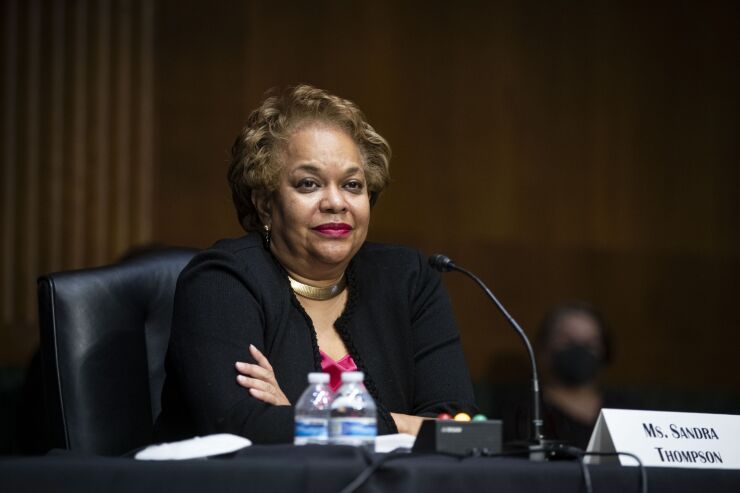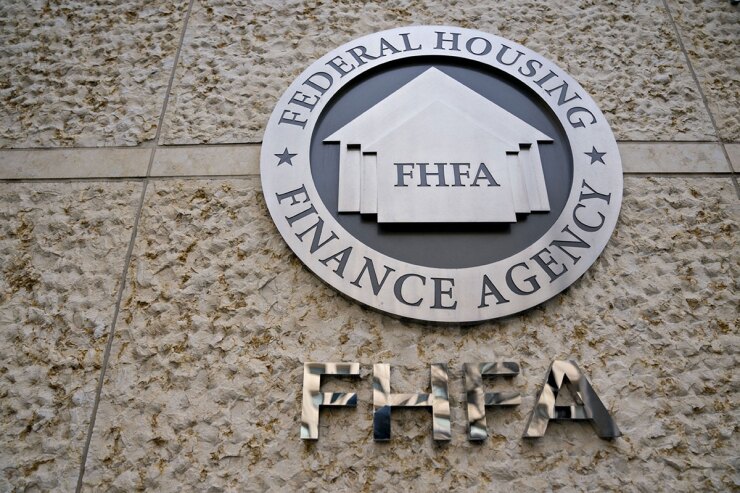Dozens of community bankers flocked to Washington this past week to discuss the relevance of the Federal Home Loan Bank System. The regulatory review may determine whether the little-known but politically powerful cooperative is fulfilling its congressionally mandated
One by one, small community bankers and housing experts spoke virtually or from a lectern in the high-ceilinged auditorium at Constitution Center the headquarters of the banks' regulator, the Federal Housing Finance Agency.
FHFA Director Sandra Thompson this summer launched

Of the 85 speakers who were each given just six minutes to talk as part of a three-day "listening session" by the FHFA, roughly 75 were either community bankers that are members of the system or nonprofit housing groups that rely on the system for affordable housing grants. Many spoke about the need to "do no harm" to a system that provides low-cost funding and local expertise.
"The Federal Home Loan Bank of Des Moines has been instrumental in our growth — we are thriving," said Deron Burr, president and CEO at People's Bank of Seneca, a $360 million-asset bank in Seneca, Missouri, which is majority-owned by the Eastern Shawnee Indian Tribe of Oklahoma.
Elizabeth Albano, president and CEO of Artisans' Bank, said her mutual institution uses FHLB advances as a main funding source in addition to deposits.
"If mutual-owned banks did not have access to the FHLB we would have to reduce our small-business lending," Albano said at one of the listening sessions. "Access to FHLB products supports interest rate risk and allows us to compete."
Stretching from San Francisco to Boston, the 11 regional Home Loan banks were established during the Hoover administration in 1932 during the depths of the Depression, when hundreds of small savings and loans went bankrupt and millions of borrowers defaulted. The system was created to provide banks and thrifts with greater liquidity to allow them to purchase home loans.
But the mortgage market has changed dramatically in the past 90 years, and is now dominated by nonbank lenders. Some critics — including former Federal Reserve Gov.
Largely absent from the listening tour that ended on Oct. 2 were large banks and insurance companies. Big banks and insurers such as MetLife, JPMorgan Chase and TIAA, were among the top 10 users of FHLB funding last year, accounting for more than 70% of advances at five of the 11 Home Loan Banks, according to the bank's financial reports. So while smaller banks have been defending the system as it is, it is larger banks, nonbanks and insurance companies that are actually the primary beneficiaries — a significant blind spot in the FHFA's listening session inquiry.
A banker's bank
The Home Loan banks essentially operate as a "banker's bank," with its members pledging mortgages as collateral to obtain funding in the form of "advances," essentially loans with variable rates and terms. Critics claim the system has an inherent conflict between its public goals and private incentives. Some suggest the Home Loan banks may no longer be relevant given the creation of the Federal Deposit Insurance Corp. and the secondary mortgage market dominated by Fannie Mae and Freddie Mac.
"The Home Loan banks were created because of market failures and those failures have been addressed through FDIC insurance and the secondary mortgage market," said Stephen Cross, the former deputy director of Home Loan bank regulation at the FHFA and now a senior advisor at Alvarez & Marsal. "As the FHFA looks at the future of the Federal Home Loan banks, this is an issue that has to be on the table and should be looked at."
The Home Loan banks issue securities that come with a government guarantee. Like Fannie Mae and Freddie Mac, they are government-sponsored enterprises regulated by the FHFA. A key
In June, Tarullo and two Fed economists published

Nonetheless, community bankers and Home Loan bank executives mostly described the close local relationships with their Home Loan banks. They said the liquidity serves as a bedrock of the financial system.
"The liquidity backstop as provided by the [FHLB] system … is paramount to managing an effective financial institution," said William Marsh, chairman, president and CEO of Farmers National Bank of Emlenton and its parent, Emclaire Financial Corp.
"Federal Home Loan bank credit lines support daily funding management, the ability to compete with larger institutions and for liquidity and funding strategies," said Marsh, who also serves as chairman of the Federal Home Loan Bank of Pittsburgh.
For years, the Home Loan banks have operated under the radar. Many of the speakers were staunch supporters of the system, claiming that the banks provide a critical role in times of crisis and have not suffered losses in 90 years.
"Why is it that nobody knows who the Federal Home Loan Banks are?" asked Tom Vartanian, executive director of the Financial Technology and Cybersecurity Center and a former law professor and Home Loan bank general counsel. "The answer to that question is they have never messed up."
While technically true, no one specifically mentioned the banks'
A few speakers noted the importance of the FHLBs as "a lender of last resort," and cautioned about the need for the system as rates increase. In 2008, bank borrowings from the FHLBs ballooned to $900 billion when the system served a role similar to the Fed's discount window, experts said.
"I would look at the Home Loan Banks as the backstop, the place that people can look — as we did in the 1930s, as we did in 2009 and as we did in 2020 — when the Home Loan banks were the only game in town," said Chris Whalen, chairman of Whalen Global Advisors. "We have to protect and strengthen them because that's the most important role of all."
Community bankers largely urged the FHFA to make no changes to the regional structure of the Home Loan Bank System. Most bankers and bank trade groups have rejected
Advances vs. deposits
With interest rates rising, one prominent critic is claiming that the banks are turning to the Home Loan banks in lieu of depositors for low-cost funding.
Cornelius Hurley, an adjunct professor at Boston University School of Law and a former independent director of the Federal Home Loan Bank of Boston, said banks are motivated to tap the Home Loan banks for funding, which has had a disproportionate impact on depositors — American citizens and taxpayers that the system is supposed to benefit. Depositors have been offered paltry interest rates on savings products such as certificates of deposits for a decade or more. In the past, banks would normally have had to raise rates for funding.
"The upshot is that it is cheaper for banks to borrow from the FHLBs than from their own depositors," said Hurley, who has become a vocal critic of the system.

Banks may have another reason not to increase deposits: Community Reinvestment Act obligations increase when deposits rise, said Jesse Van Tol, president and CEO of the National Community Reinvestment Coalition.
"This kind of funding from the Federal Home Loan banks might actually incentivize banks to not seek more deposits, and they may, in some sense, be evading their CRA obligations," Van Tol said. "If you grow your deposits, it creates a [Community Redevelopment Act] obligation that's different and banks also have a greater community development investment obligation based on their deposit share."
At the listening sessions, some of the speakers seemed to be speaking to each other.
F. Daniel Siciliano, chairman-elect of the Council of Federal Home Loan Banks and an independent director of the Federal Home Loan Bank of San Francisco, rejected the criticism that depositors were losing out on higher rates because banks are turning to the FHLBs for funding. He called the system "a design masterpiece."
"During times of crisis the FHLBs do not divert interest payments from being made to depositors but rather provide a liquidity function to better weather economic cycles," said Siciliano, a former professor and dean at Stanford University.
Affordable housing
Though affordable housing is not part of the mission of the Home Loan banks, it dominated the discussion. The banks are mandated to set aside 10% of their profits for affordable housing. Last year the banks provided $352 million for affordable housing in the form of grants and other programs. Most of the speakers said the funding was desperately needed but was not enough to have a big impact and that many of the banks' requirements are too onerous.
Siciliano said the system works well and should be left alone, though he conceded that profits set aside for affordable housing "should be expanded."
Multifamily housing projects use a patchwork of funding sources, notably low-income housing tax credits to cover 60% of the costs of a project. It currently costs roughly $400,000 per unit to build an affordable housing project, but a Home Loan bank's so-called gap financing amounts to roughly 2.5% of a project's cost. Grants typically provide eligible borrowers with $10,000 in down payment assistance.
While there appears to be keen interest in the outcome of the FHFA's review given the number of speakers at the listening sessions, it remains unclear if any concrete changes are likely. Home Loan bank executives are concerned that any review will draw the interest of Congress, which could prompt legislative changes.
But others note that the Home Loan banks have a core constituency, with small community banks in every state ready to alert Republicans of their importance. Meanwhile, state housing agencies and affordable housing advocates have ready allies in congressional Democrats. Without a crisis or notable bank failure, there is little impetus for reform.
Moreover, last year the Supreme Court ruled that
"The slowness to change is a feature and not a bug," said Siciliano. "A system with a strong emphasis on safety and soundness can evolve carefully."





